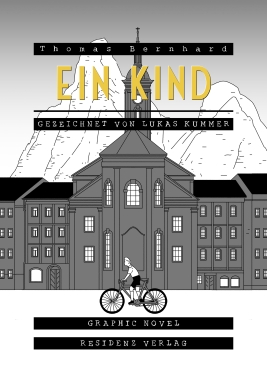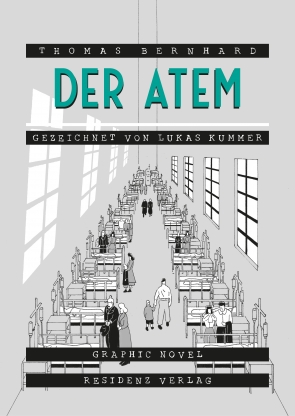Es ist ein Meisterwerk eigenen Rechts, das hier entsteht, und man kann nur bedauern, dass Kummer mit „Ein Kind“ wohl aufhören wird, Bernhard zu zeichnen, weil Residenz dann seinen Rechtevorrat erschöpft hat.
[Quelle: Andreas Platthaus, FAZ]
(...) Lukas Kummer arbeitet sich seit 2015 an Bernhards Werk ab – und hat dafür eine kongeniale, serielle Erzählweise gefunden. In sich minimal variierenden Bildern wird da von Monotonie, Isolation und Entfremdung erzählt.
[Quelle: Karin Cerny, PROFIL]
(...) setzt Kummer nicht darauf, Humanismus mit Lakonie zu verbinden, sondern betont die Leidensgeschichte in ihrer Abgeschiedenheit und scheinbaren Ausweglosigkeit. Nur zwischendurch blitzt ein wenig Boshaftigkeit auf, wenn etwa über große und kleine, geniale und mittelmäßige Künstler und Schriftsteller des Landes sinniert wird - und die Dargestellten Wiedererkennungswert bekommen, prominente Zeitgenossen inklusive. Ansonsten ist die Atmosphäre von Spitalsräumen, Kirchenschiffen und Alpenpanoramen durchaus beängstigend.
[Quelle: APA]
Seine Bilder in Grau, Weiß und Schwarz passen sich dem Rhythmus der Sprache an. Auf den ersten Blick zeigen sie unaufgeregt, was erzählt wird. Auf den zweiten offenbart sich dann das ganze Bernhardsche Drama.
[Quelle: MERKUR]
Zwar sind die im Buch geschilderten Nachkriegszustände extrem. Sie sind aber gleichwohl insoweit aktuell, dass sie eine Klassenmedizin zeigen, in denen nur der Selbstzahler eine ausreichende Menge an Medizin erhält. Zur Gesundung braucht es mehr als ein Krankenhaus, es braucht auch Wohlbefinden, seelische Erbauung und menschliche Wärme. Dies wird mit Händen greifbar durch die erneut sehr gelungene Kombination aus Bernhards Text und Kummers Bildern dieser berührenden Graphic Novel.
[Quelle: Anka Willamowius, BUCH-LADY.DE]
Kummer fängt wie in den vorangegangen Bänden die Essenz des Bernhard-Textes perfekt ein. Das Buch bzw. die ganze Serie kann jedem „Bernhardianer“, aber auch jedem Novizen nur wärmstens ans Herz gelegt werden.
[Quelle: Oliver Herzig, BÜCHER BÜCHER BÜCHER]
Durch die furchtbar genialen Zeichnungen von Lukas Kummer findet man Zugang zum Werk des großen Grantlers.
[Quelle: Ronny Putzke, KULTUREXPRESSO]



















